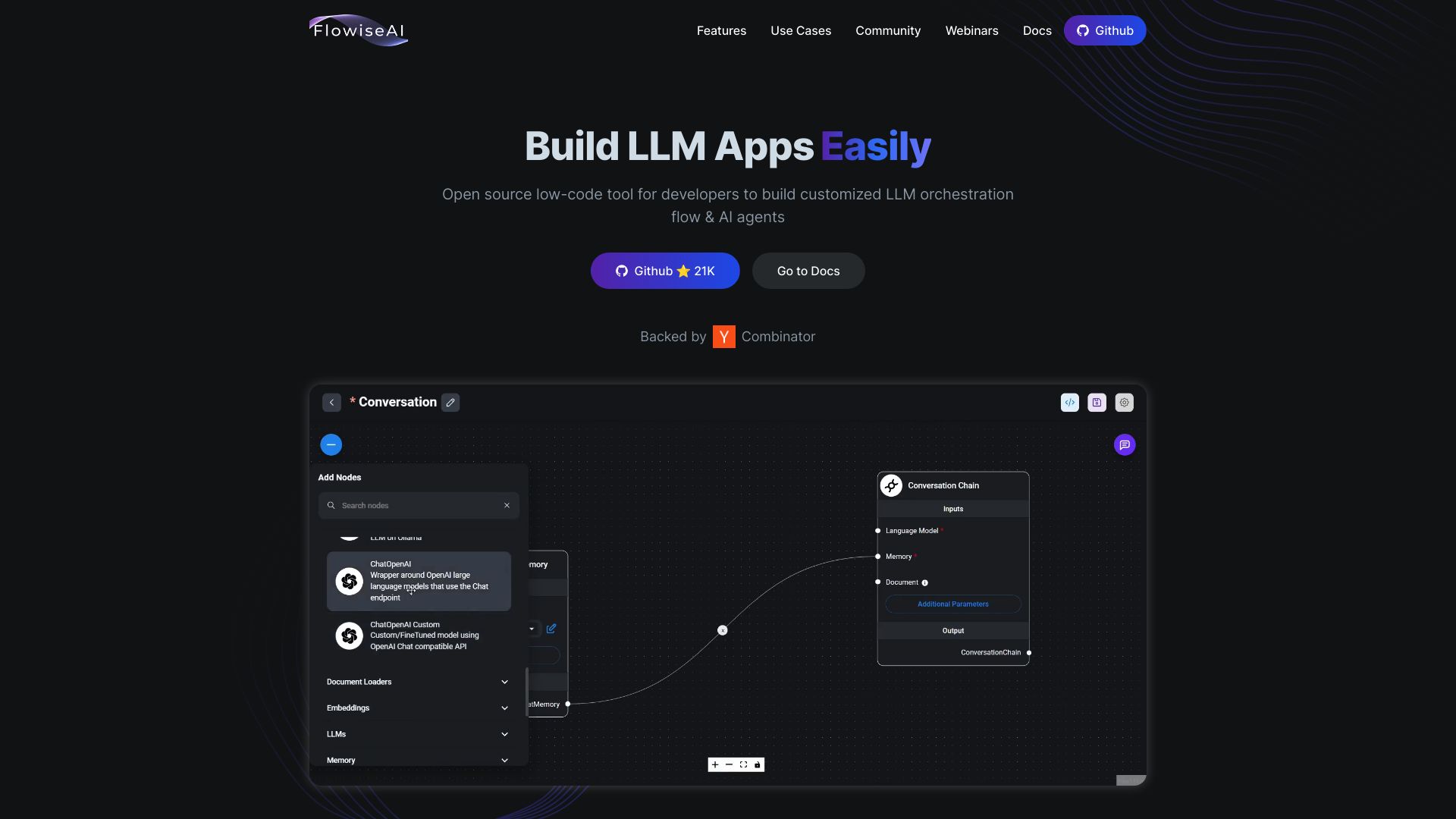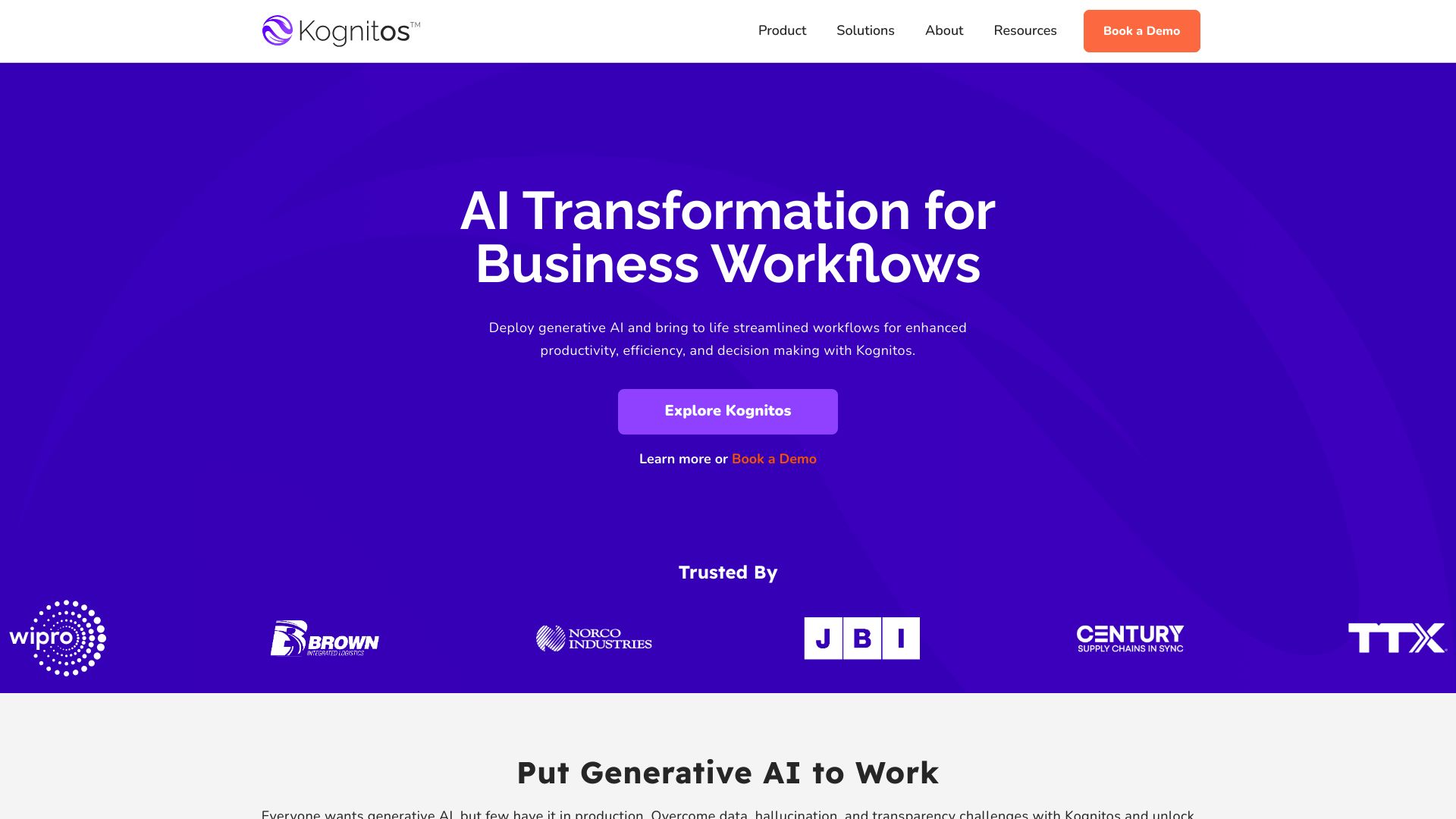FlowiseAI vs. Kognitos: A Comparative Analysis of AI Automation Platforms
AI-powered automation tools have become essential for businesses seeking to streamline operations and boost productivity. FlowiseAI vs. Kognitos stand out as innovative platforms in this space, each offering unique approaches to AI agent development and workflow automation. This comparison explores the key features, strengths, and limitations of both platforms, providing insights into their capabilities for building sophisticated AI applications. We’ll delve into FlowiseAI’s visual workflow design and Kognitos’ natural language interface, examining how each platform caters to different user needs and technical requirements. By evaluating these tools alongside SmythOS, we aim to help you make an informed decision about the best AI development platform for your specific use case, whether you’re a developer, business leader, or AI enthusiast.
FlowiseAI Overview
FlowiseAI empowers developers to build and orchestrate AI agents using large language models (LLMs). This open-source platform simplifies the creation of sophisticated AI applications through a visual, drag-and-drop interface. FlowiseAI caters to developers seeking rapid prototyping and deployment of LLM-based solutions without deep AI expertise.
FlowiseAI empowers developers to build and orchestrate AI agents using large language models (LLMs). This open-source platform simplifies the creation of sophisticated AI applications through a visual, drag-and-drop interface.


The platform’s key strengths lie in its customization options and integration capabilities. Users can tailor LLM orchestration flows to specific needs, whether for document analysis, customer support, or other applications. FlowiseAI supports various document loaders, vector databases like Pinecone, and multiple data types including PDFs, web pages, and CSV files. This versatility makes it suitable for a wide range of use cases.
FlowiseAI supports various document loaders, vector databases like Pinecone, and multiple data types including PDFs, web pages, and CSV files. This versatility makes it suitable for a wide range of use cases.
FlowiseAI’s modular approach employs an agent and chain system. Developers link various nodes such as document loaders, text splitters, and LLMs to create complex workflows. This design simplifies the creation and management of AI processes, allowing for intricate agent behaviors without extensive coding.
While FlowiseAI offers powerful features for AI development, it may present a learning curve for non-technical users. The platform’s focus on customization and integration could require some programming knowledge to fully leverage its capabilities. Additionally, as an open-source tool, enterprise-grade support and certain advanced features may be limited compared to commercial alternatives.
FlowiseAI positions itself as a versatile solution in the competitive landscape of AI development tools. Its strengths in customization, visual workflow design, and integration capabilities make it attractive for developers and organizations looking to implement tailored AI solutions. However, users seeking extensive no-code options or comprehensive enterprise support might find other platforms more suitable for their needs.
Kognitos Overview
Kognitos revolutionizes AI-based automation with its innovative platform that leverages plain English commands. Users create, manage, and troubleshoot automation workflows using natural language, eliminating the need for complex coding or traditional bot management.


The platform combines generative AI with traditional logic, enabling powerful and efficient automation that learns and adapts over time. Kognitos runs entirely from a browser, utilizing stable API-based automations instead of relying on Windows-dependent bots. This approach enhances flexibility and reduces maintenance overhead.
Kognitos excels in document processing, Excel manipulation, email handling, and integration with systems like Salesforce. Its self-learning capabilities allow it to handle exceptions by learning from user input…
Kognitos excels in document processing, Excel manipulation, email handling, and integration with systems like Salesforce. Its self-learning capabilities allow it to handle exceptions by learning from user input, making it highly adaptable to process changes and variations. The platform seamlessly integrates with third-party applications and supports multiple operating systems, offering broad compatibility.
While Kognitos offers impressive automation capabilities, potential drawbacks include a learning curve for users unfamiliar with natural language interfaces and possible limitations in highly specialized or niche industry applications. The platform’s effectiveness may also depend on the quality and consistency of user inputs, requiring clear communication practices within teams.
Kognitos aims to democratize AI power by making automation accessible through natural language. This vision positions the platform as a transformative tool for businesses seeking to streamline operations and adapt to changing industry demands. By focusing on user-friendly automation and leveraging generative AI, Kognitos sets a new standard for how businesses can harness AI advancements while maintaining human control and oversight.
Feature Comparison
FlowiseAI and Kognitos offer distinct approaches to AI agent development, with notable differences in their core components and security features. FlowiseAI provides a visual, drag-and-drop interface for building AI workflows, catering to developers seeking rapid prototyping of LLM-based solutions. It excels in customization options and integration capabilities, supporting various document loaders and vector databases. FlowiseAI’s modular approach employs an agent and chain system, simplifying the creation of complex workflows.
In contrast, Kognitos revolutionizes AI-based automation by leveraging plain English commands. Users create and manage automation workflows using natural language, eliminating the need for complex coding. Kognitos combines generative AI with traditional logic, enabling powerful automation that learns and adapts over time. It runs entirely from a browser, utilizing stable API-based automations instead of relying on Windows-dependent bots.
While both platforms offer hosted agents and support for different environments, Kognitos stands out with its self-learning capabilities and seamless integration with third-party applications across multiple operating systems. FlowiseAI, however, may have an edge in developer-focused features like debug mode and extensive customization options. In terms of security, both platforms implement data encryption and OAuth, but SmythOS offers additional features like constrained alignment and IP control, providing a more comprehensive security solution for enterprise needs.
Feature Comparison Table
| FlowiseAI | Kognitos | SmythOS | |
|---|---|---|---|
| CORE FEATURES | |||
| Hosted Agents (Dev, Production) | ❌ | ✅ | ✅ |
| Environments (Dev, Production) | ❌ | ✅ | ✅ |
| Visual Builder | ✅ | ❌ | ✅ |
| Debug Tools | ❌ | ✅ | ✅ |
| Multi-Agent Collaboration | ❌ | ✅ | ✅ |
| Audit Logs for Analytics | ❌ | ✅ | ✅ |
| Work as Team | ❌ | ✅ | ✅ |
| SECURITY | |||
| Constrained Alignment | ❌ | ❌ | ✅ |
| OAuth | ❌ | ✅ | ✅ |
| IP Control | ❌ | ❌ | ✅ |
| COMPONENTS | |||
| Zapier APIs | ❌ | ❌ | ✅ |
| Classifiers | ❌ | ✅ | ✅ |
| Data Lakes | ❌ | ❌ | ✅ |
| DEPLOYMENT OPTIONS (EMBODIMENTS) | |||
| Deploy as Webhook | ✅ | ❌ | ✅ |
| Staging Domains | ❌ | ✅ | ✅ |
| Production Domains | ❌ | ✅ | ✅ |
| Deploy as Site Chat | ✅ | ❌ | ✅ |
| Deploy as Scheduled Agent | ❌ | ✅ | ✅ |
| Deploy as GPT | ✅ | ❌ | ✅ |
| DATA LAKE SUPPORT | |||
| Hosted Vector Database | ❌ | ❌ | ✅ |
| Sitemap Crawler | ❌ | ❌ | ✅ |
| YouTube Transcript Crawler | ❌ | ❌ | ✅ |
| URL Crawler | ✅ | ❌ | ✅ |
| Word File Support | ❌ | ✅ | ✅ |
Best Alternative to FlowiseAI and Kognitos
SmythOS emerges as the superior alternative to FlowiseAI and Kognitos for AI agent development and deployment. Our platform combines the best of both worlds, offering a user-friendly visual builder like FlowiseAI and powerful automation capabilities akin to Kognitos, while surpassing both in overall functionality and ease of use.
We designed SmythOS with a focus on versatility and unlimited use cases. Unlike FlowiseAI’s developer-centric approach or Kognitos’ emphasis on natural language automation, our platform caters to a wide range of users, from non-technical professionals to experienced developers. The intuitive drag-and-drop interface allows for rapid prototyping and deployment of AI agents without sacrificing advanced customization options.
SmythOS emerges as the superior alternative to FlowiseAI and Kognitos for AI agent development and deployment… offering a user-friendly visual builder like FlowiseAI and powerful automation capabilities akin to Kognitos
Our extensive feature set sets SmythOS apart from competitors. We offer hosted agents for both development and production environments, ensuring seamless transitions from testing to live deployment. The platform supports multi-agent collaboration, enabling complex workflows that neither FlowiseAI nor Kognitos can match. Additionally, SmythOS provides robust debugging tools, audit logs for analytics, and the ability for agents to work as a team, surpassing the capabilities of both alternatives.
Security is paramount in AI development, and SmythOS leads the pack with features like constrained alignment and IP control, which are absent in both FlowiseAI and Kognitos. We also support OAuth authentication and data encryption, ensuring your AI agents operate in a secure environment. These advanced security measures make SmythOS the ideal choice for enterprises and organizations with stringent data protection requirements.
The true power of SmythOS lies in its unparalleled flexibility and scalability. We support a wide array of deployment options, including APIs, webhooks, site chats, scheduled agents, and even deployment as GPTs. This versatility, combined with our hosted vector database and support for various data sources, enables users to create AI solutions for virtually any use case imaginable. Whether you’re building a customer service chatbot, automating complex business processes, or developing cutting-edge AI applications, SmythOS provides the tools and infrastructure to bring your vision to life efficiently and effectively.
Conclusion
FlowiseAI and Kognitos offer powerful AI development tools, each with unique strengths. FlowiseAI excels in customization and visual workflow design, making it attractive for developers seeking rapid prototyping of LLM-based solutions. Kognitos stands out with its natural language interface and self-learning capabilities, appealing to users who prioritize ease of use and adaptability.
However, SmythOS emerges as the superior choice, combining the best of both worlds and offering additional advantages. Our platform provides unparalleled flexibility with its drag-and-drop interface, extensive integration ecosystem, and support for multiple AI models. SmythOS’s ’Create Once, Deploy Anywhere’ approach allows seamless deployment across various platforms, from ChatGPT plugins to Alexa skills.
Unlike FlowiseAI and Kognitos, SmythOS offers advanced features such as multi-agent collaboration, comprehensive security measures including constrained alignment and IP control, and a robust data management system with hosted vector databases. These capabilities make SmythOS ideal for businesses seeking scalable, enterprise-grade AI solutions that can adapt to complex workflows and industry-specific needs.
To experience the transformative power of SmythOS, we invite you to explore our diverse range of AI-powered agent templates. These templates cover multiple business categories and offer a quick start to revolutionizing your workflows. For those ready to dive in, you can create a free SmythOS account and start building AI agents with no time limit. Unleash the full potential of AI for your business and join the economic revolution that SmythOS is driving across industries.
Last updated:
Disclaimer: The information presented in this article is for general informational purposes only and is provided as is. While we strive to keep the content up-to-date and accurate, we make no representations or warranties of any kind, express or implied, about the completeness, accuracy, reliability, suitability, or availability of the information contained in this article.
Any reliance you place on such information is strictly at your own risk. We reserve the right to make additions, deletions, or modifications to the contents of this article at any time without prior notice.
In no event will we be liable for any loss or damage including without limitation, indirect or consequential loss or damage, or any loss or damage whatsoever arising from loss of data, profits, or any other loss not specified herein arising out of, or in connection with, the use of this article.
Despite our best efforts, this article may contain oversights, errors, or omissions. If you notice any inaccuracies or have concerns about the content, please report them through our content feedback form. Your input helps us maintain the quality and reliability of our information.
